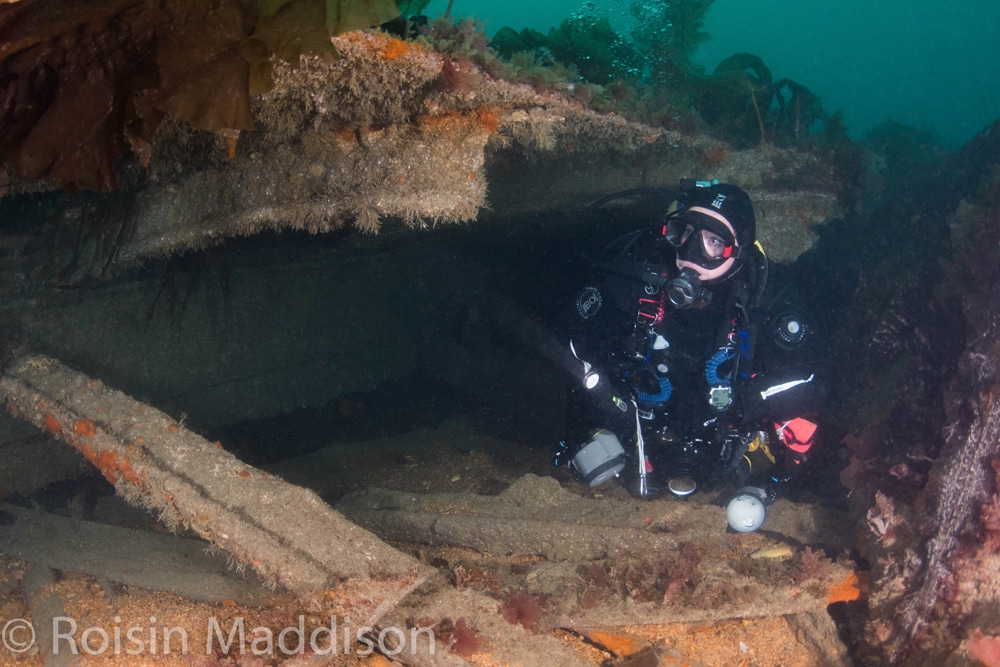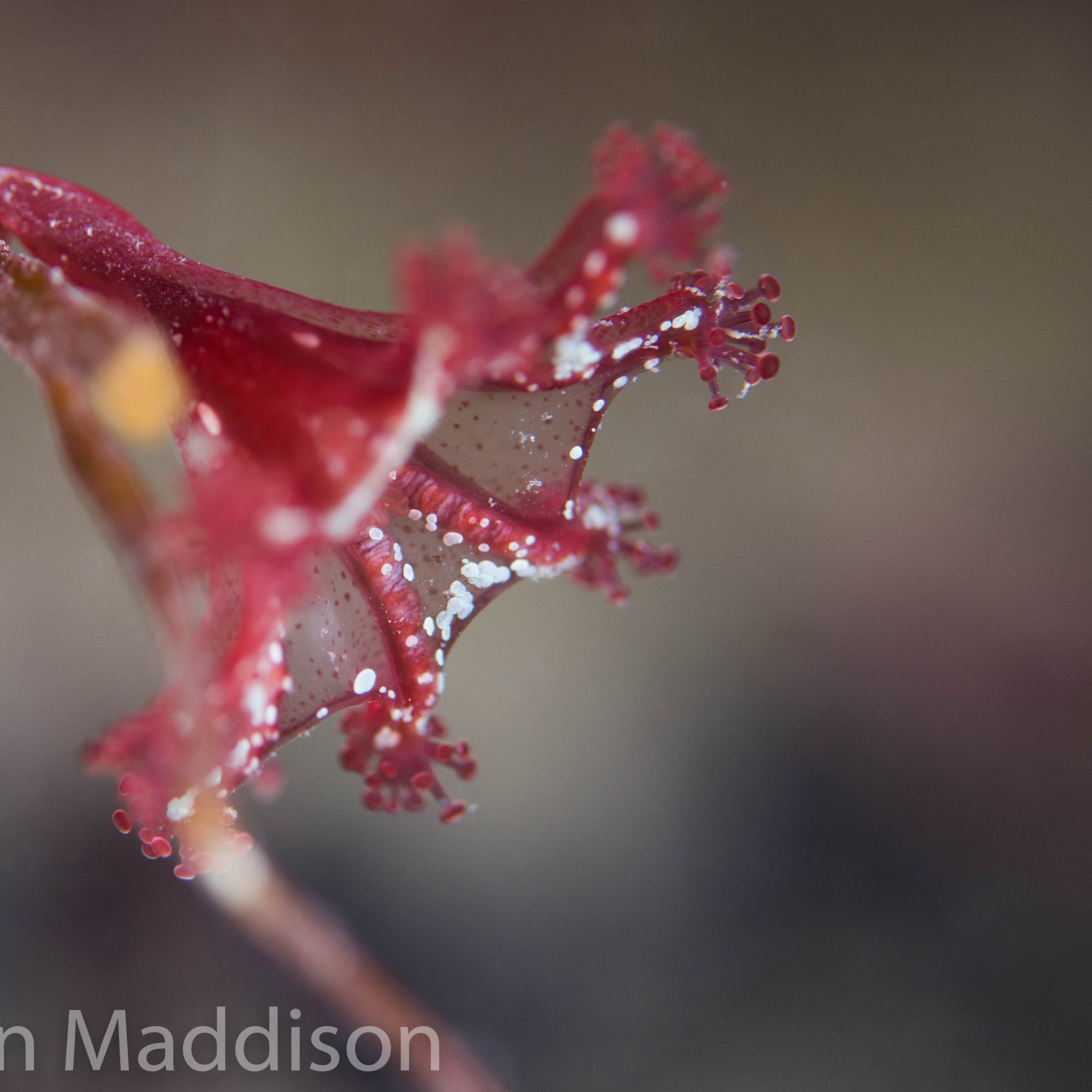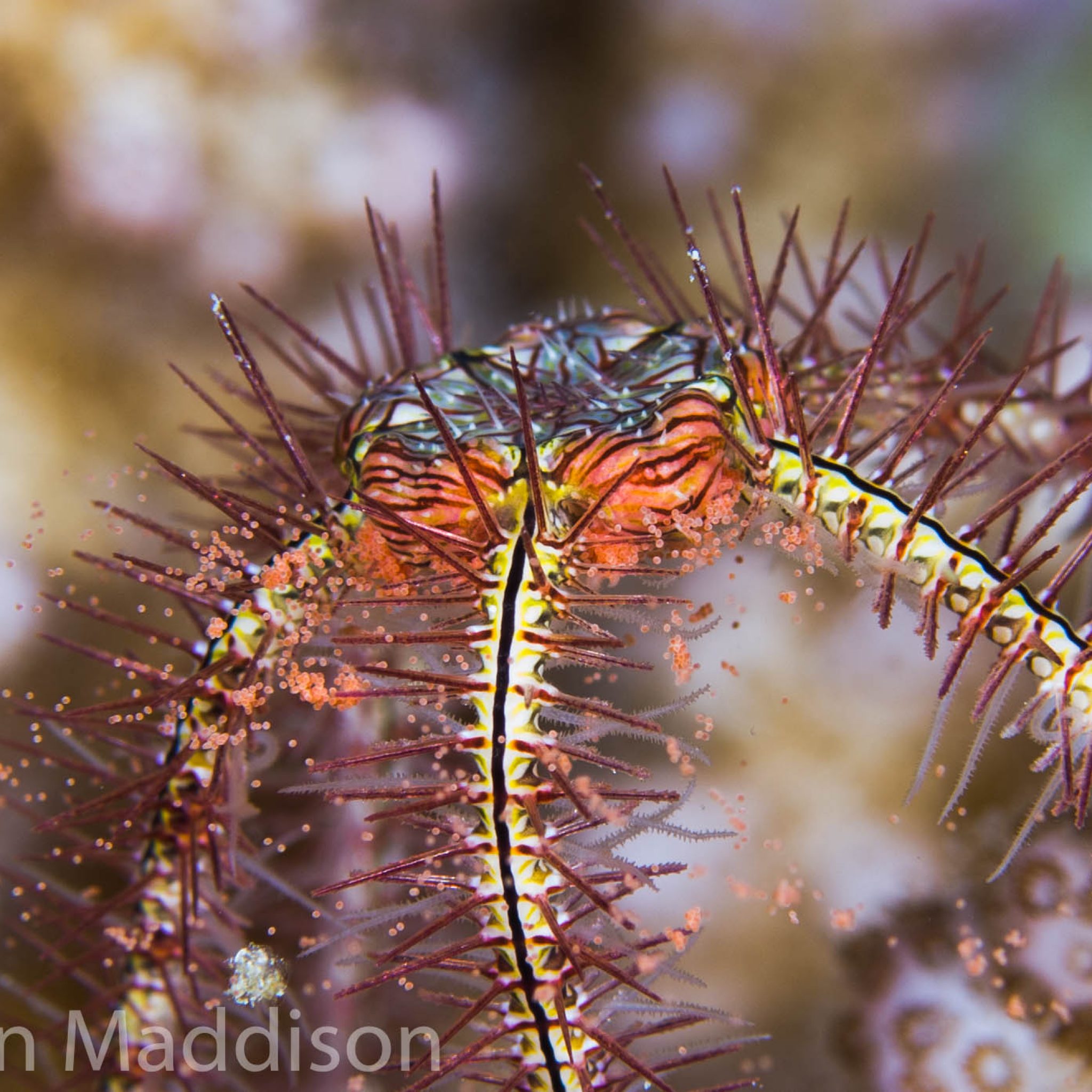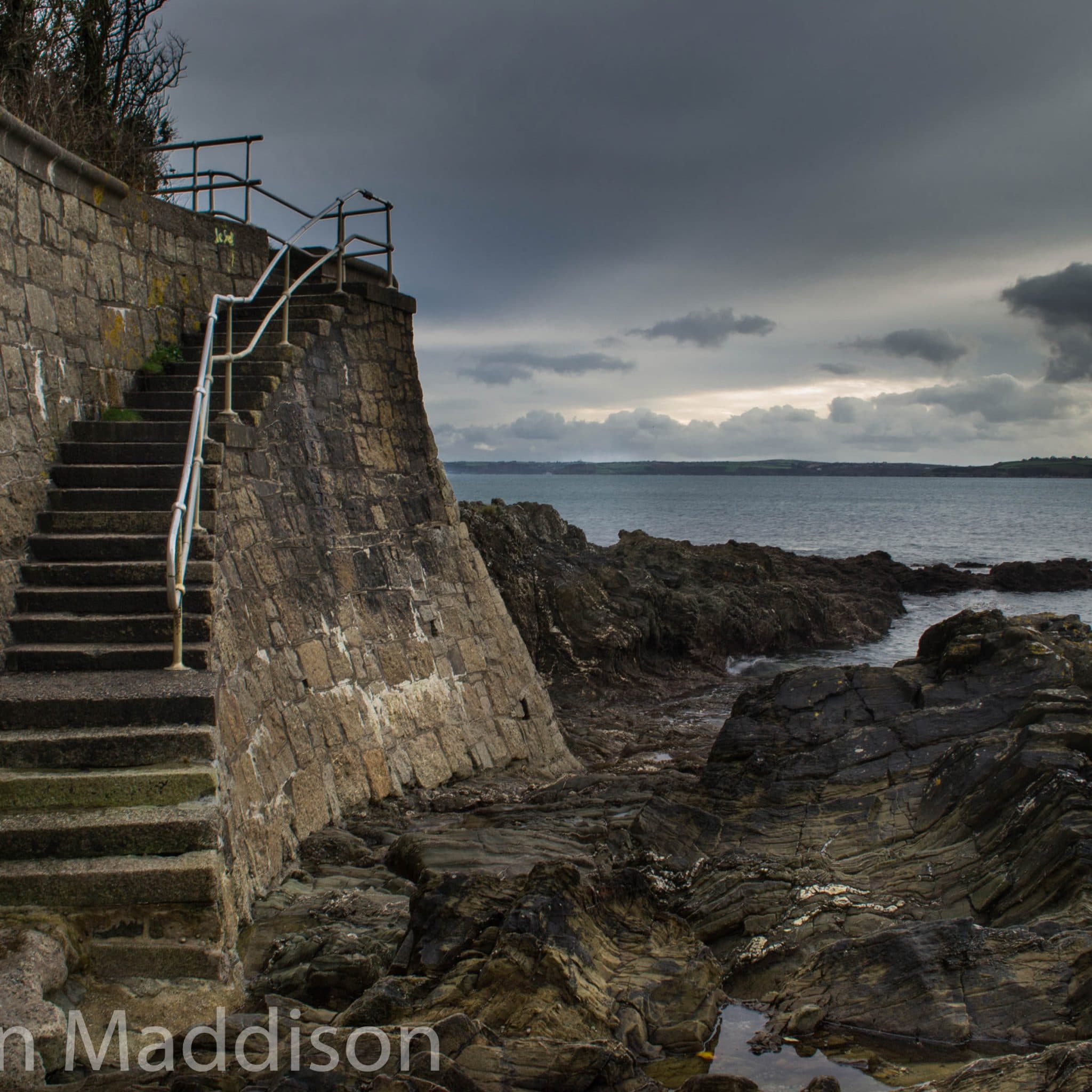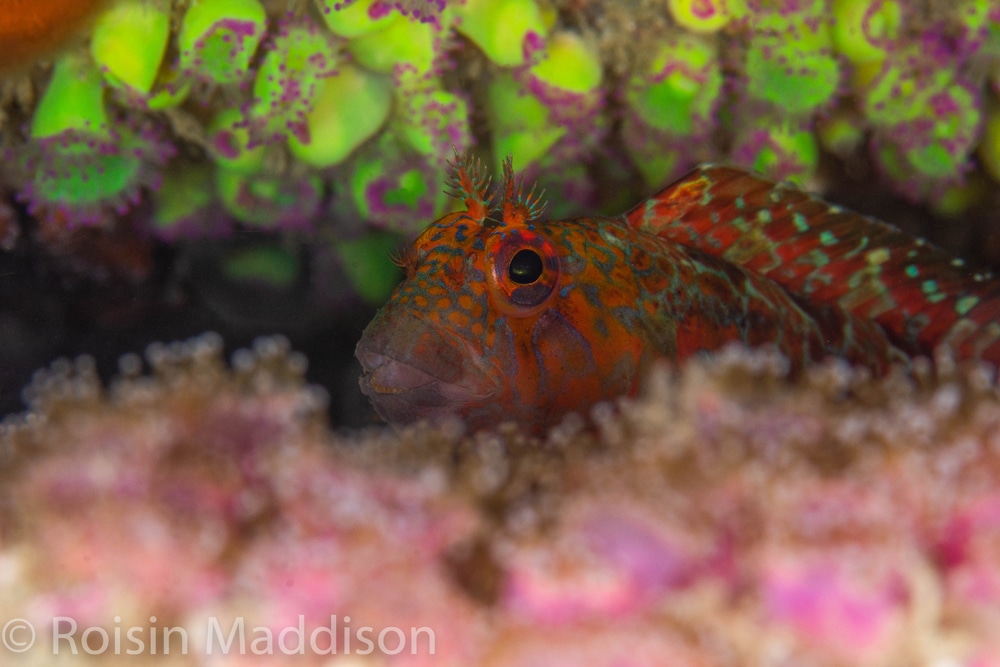Photo / Video News & Reviews
Scubaverse Underwater Photographer Interview: Roisin Maddison
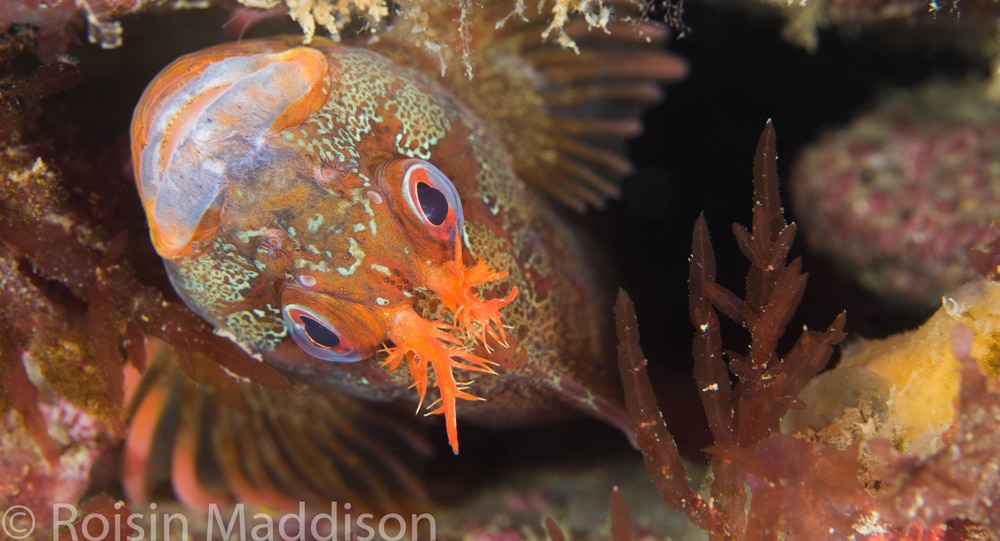
In an ongoing series, Scubaverse’s Underwater Photography Editor Nick Robertson-Brown talks to underwater photographers from around the world that he admires. In this blog: Roisin Maddison
NRB: How did your underwater photography start?
RM: Growing up with a mountaineer for a father I spent the majority of my childhood in the British countryside running around with my dad’s old compact film camera bossing people around telling getting them to pose for photos or to get out of my way of my shot. Back then it would take months to get the photos developed, mostly due to the fact that my dad never took them to the photo shop and would end up stockpiling rolls upon rolls of film but also because he would inevitably forget to go and pick them up when he eventually did.
It was on my 12th birthday that my dad bought me my first digital camera, a small Olympic compact that I’m pretty sure I still have hidden in a box in my old bedroom. It was from there that my photography really kicked off, now that I could see what photos I was taking, and I no longer had to wait months to receive the final product only for it to be blurred or out of focus.
It was however one of my high school art teachers that encouraged me to take my photography seriously and to take it on into my A-levels where I found that I really did have a talent and a passion for photography, favouring it over all of my other “academic” subjects.
It was a given that I was going to go on and study photography at University but nature photography was always my passion, I just couldn’t be bothered with the fashion or street photography elements of my course and I was adamant that I wanted to be based near the sea. However, all the courses I researched or came across were all heavily based on editorial, fashion, urban photography areas that I just wasn’t interested in. Until I came across Falmouth University’s Marine and Natural History Photography course. It was ideal. It was near the sea and it was a course based entirely on nature photography; it even had a diving element, which sounded like a bit of fun. At this stage I had never Scuba dived, I was an avid swimmer, but Scuba diving was never something I had considered doing, it just wasn’t on my radar but what the hell! It’ll be fun, I’ll give it a go.
Little did I know whilst on my first open water dive in the Delph Quarry or on my first university dive at Pendennis Silver Steps that Scuba diving and underwater photography was about to consume my entire life.
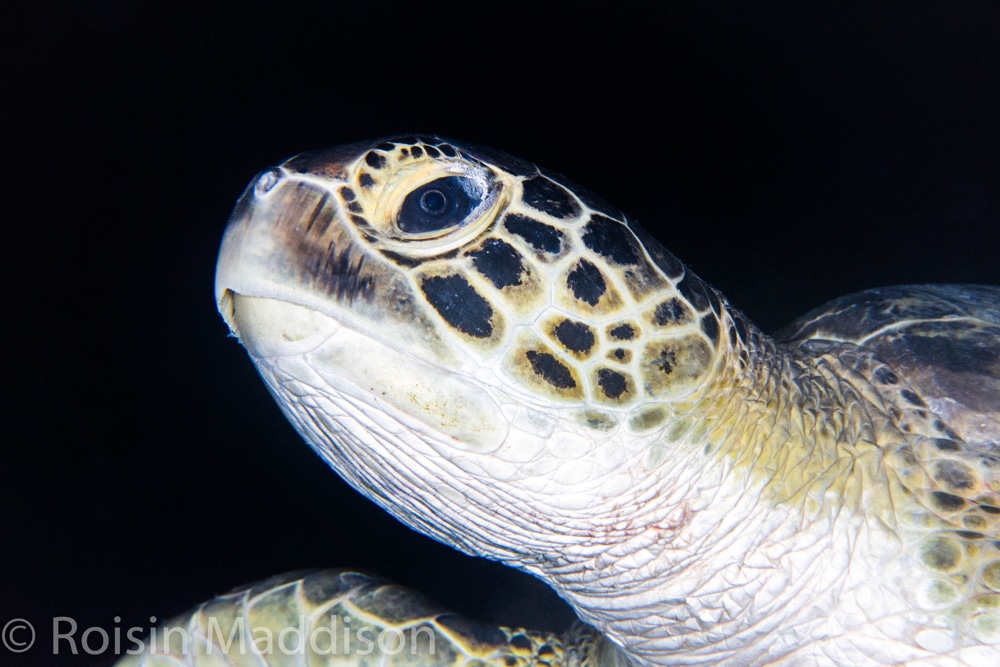 NRB: What is your favourite u/w camera equipment (past & present) & why?
NRB: What is your favourite u/w camera equipment (past & present) & why?
RM: My first underwater photography dive was done with a compact Panasonic set up with a single strobe. Once we had proved ourselves trustworthy, we graduated on to a Nikon D7000 and Nauticam housing with either a 60mm macro or the Tokina 10-17 fisheye lens. When I graduated university and no longer had access to the uni’s cameras I treated myself to Nauticam housing for my D7200 and a 60mm macro. For about 2 years this 60mm macro was the only dome port I owned; underwater photography equipment isn’t cheap, especially for a recent photography graduate. Whilst I have since expanded my equipment collection and tried out other cameras and set ups, my D7200 and my trusty 60mm macro will always be my go-to set up. The 60mm is just such a versatile lens. It is a macro lens but it’s perfect for those slightly larger profile creatures, that aren’t quite big enough to warrant a wide angle, whilst also being perfect for any teeny tiny macro critters. Admittedly it doesn’t get as close or as much detail as the 105mm macro but if a turtle swims past whilst you have the 105mm on you have no chance. With the 60mm it may not be the perfect shot but you are at least in with a chance. Plus, there’s always room for a bit of cropping where those teeny tiny critters are concerned.
NRB: What would be your advice to anyone new to underwater photography?
RM: I would recommend getting to grips with manual setting and light set ups straight from the off, set yourself up in a nice shallow reef with a VERY patient buddy (even better a buddy who is already an underwater photographer that can advise you) and start off by practicing different settings and lighting techniques on a simple and static subject; anemones are always a good shout.
Underwater photography workshops are always a massive boost when starting out as well as underwater photography books. Alex Mustards book Underwater Photography masterclass is my absolute go-to when trying out a new technique. But remember even if you are an amazing photographer top side and an experienced diver, it is going to take a lot of time and effort to get to grips with underwater photography and undoubtedly your first few images are not going to be perfect. But stick with it because when you get your first perfect shot, all that time and effort will be worth it.
NRB: What, or who, has been your single biggest inspiration for your underwater photography?
RM: My biggest inspiration for underwater photography has got to be Jane Morgan, not only is she an amazing underwater photographer who has had many amazing articles and images published over the years, but she is also a genuinely kind and caring person who wants to help and inspire the next generation of underwater photographers. Many other Marine and Natural History students and I have had the pleasure of having her as our tutor and all-round photography guru. Over the years she has had to put up with my badgering her for tips and tricks, but she has always been there to lend a piece of equipment or teach me a new technique. She helped me get my first magazine article published and all round cheered me on to pursue a career in underwater photography.
NRB: What image are you most proud of and why?
RM: This is a hard question to answer, I am proud of so many of my images and I don’t think I would be able to choose just one. Quite often my favourite images from a dive or a trip aren’t necessarily the best photographs or the most technical, they are the ones that have the best memories and the most meaning to me.
To name just one is hard but I think I would have to pick a photograph I took in Egypt two years ago. I dropped down on a night dive and the first thing I came across was a brittle star. It was stood up on its arms holding its body in the air, which was strange behaviour that I had never come across before, so I stopped to photograph it and as I did it started spawning right in front of my camera lens. I was amazed and privileged to get to witness such an amazing bit of nature.
NRB: Where is your favourite dive location, and is it for the photography?
RM: My favourite dive location is a little 5m shore dive off the coast of Falmouth. Pendennis Sliver Steps is the easiest most simple dive site you will ever visit but it is also the most stunning. It is the perfect dive site to jump into on your way home from work and get a bit of photography practice in, whether its testing out new equipment or techniques or just keeping your hand in during a busy period, or when the weather has prevented you from getting out anywhere else. Most importantly of all it is bursting with life, there are new species to find on nearly every dive but being such an easy dive site to jump into means I can spend so much time there and get to know to resident species, figuring out where they live, tracking their behaviours and markings throughout the year and each time getting to take better and more technical photographs.
NRB: What are you views on marine life manipulation, moving subjects?
RM: Personally, I am not one for marine life manipulation whether it be in water whilst taking the picture or in post edit. I like my photos to reflect what I saw on the dive as it was when I took the photo. I will however admit to occasionally doing a bit of ‘gardening’ and removing a stray bit of seaweed or two out of the way of the frame, but that is as far as I will go.
NRB: What do you look for when you are making your images?
RM: It very much depends on what dive I’m on and what I am taking the photograph for. If I am out on a pleasure dive, I will be looking for images with a difference. Every photographer wants to take that one image that nobody has ever taken before, but I will also be taking photographs for myself to document my dive and the species I found sometimes for my own memories and sometimes for species research and/or magazine articles. I think it’s very important for photographers not to get to bent up in taking the perfect image on every dive. Whilst underwater photography may be my chosen profession it is also my hobby and it is very important to me that I don’t turn my hobby, my escape, my passion, into an obsession or ruin it by making it feel too much like work.
NRB: What motivates you to take u/w photos?
RM: I take underwater photographs to create an awareness for non-divers as to the beauty and importance of our marine world. More specifically for me is a desire to exhibit how stunning and extensive our own British marine life is. In the last few years the threat to our Coral Reefs and tropical oceans has finally been taking seriously and divers and non-divers have finally realised the importance of our oceans and how imperative it is to save them. I want my photography to highlight that it isn’t just the tropical coral reefs that need savin. British marine habitats are just as important and just as exquisite.
NRB: If you could photograph any one thing/place what or where would that be?
RM: I spent 5 years living and diving in Cornish waters without ever coming across a blue shark or a basking shark. One of my aims for this next year is to get onto one of the blue shark/basking shark trips and to photograph these gentle giants in British waters.
To see more of Roisin’s work click here.
Blogs
Jeff Goodman Launches Underwater Moviemaker Course with NovoScuba

Transform Your Dive Experiences into Cinematic Masterpieces
NovoScuba has partnered with acclaimed underwater filmmaker Jeff Goodman to introduce the Underwater Moviemaker Course—a revolutionary program designed to equip divers with the skills to capture the breathtaking beauty of the underwater world.
Whether you’re an aspiring filmmaker, an avid diver, or a photography enthusiast, this course offers the tools and expertise needed to create stunning underwater videos. From vibrant coral reefs to curious marine life, you’ll learn how to film, edit, and produce captivating underwater stories, all with expert guidance from a seasoned professional.
Jeff Goodman: A Legacy in Underwater Filmmaking
Jeff Goodman brings over 40 years of experience in underwater film production for television to this course. Reflecting on his career, Jeff said:
“Although technology has dramatically changed, the basics of underwater filming remain constant. This course covers crucial skills for producing great videos. Whether you’re creating professional broadcast films or high-quality hobby videos, the fundamental principles are the same.
A camera operator must master their equipment to capture those magical underwater moments effortlessly. But beyond technical know-how, underwater filmmaking is about having fun and enhancing your diving experiences. So, take your time, learn at your own pace, and enjoy this creative journey.”
About NovoScuba
Founded in 2023, NovoScuba is reshaping dive education with a comprehensive, digitally native platform. Offering cutting-edge training programs for divers at all levels, NovoScuba sets a new benchmark in the diving industry by combining innovation with accessibility.
With ISO-certified courses, a student subscription model, and multilingual support, NovoScuba ensures that dive education is inclusive and engaging. More than just a training provider, NovoScuba fosters a global community of divers committed to exploration, collaboration, and sustainability.
Join the NovoScuba Underwater Moviemaker Course Today!
Dive into the world of underwater filmmaking and start creating cinematic stories that inspire. Learn more about the course and enroll today at www.novoscuba.com/novoscuba-underwater-moviemaker-course.
EXCLUSIVE: Jeff Goodman interviews Mark Spiers, CEO of New Scuba Diving Training Agency NovoScuba
NovoScuba’s Game-Changing Approach for Dive Store Owners: WE PAY YOU!
The diving world thrives on passion and adventure, but for many dive store owners, the financial and operational challenges can be as deep as the ocean.
NovoScuba, an emerging force in the diving world, is on a mission to transform this landscape for the better. With a revolutionary approach to dive store and training agency partnerships, NovoScuba is setting new standards for how dive stores can thrive while keeping their focus on delivering exceptional diving experiences.

A New Paradigm: NovoScuba’s Bold Mission
NovoScuba’s mission is straightforward yet profound: to disrupt the traditional dynamics between dive store owners and training agencies. Traditionally, dive stores have been subjected to substantial fees charged by training agencies, for membership, materials and certifications. These costs have often placed a heavy financial burden on store owners, cutting into their profits and limiting their ability to offer competitive prices to customers.
NovoScuba flips the script by offering a model where dive stores earn money, instead of paying high fees. Dive stores receive commissions for every student they register, and their certification costs are covered. This new model not only boosts profitability but also ensures clients get top-quality training at unbeatable prices.
Financial Upsides: Earn From Student Registration
NovoScuba’s approach is simple yet revolutionary. Dive stores partnering with NovoScuba can earn commissions for every student they enroll.
Here’s how it works: For every student enrolled through NovoScuba, dive stores receive a commission. Each student enrolled will receive their e-learning materials and certification credit included in their subscription. This arrangement is a significant departure from the traditional model, where dive stores often struggle to manage high overhead costs related to training fees and certification expenses.

NovoScuba’s approach ensures that dive stores can focus on what they do best—providing top-notch diving experiences—without being bogged down by excessive financial burdens, and the need to carry large stocks of materials.
Quality Training at a Great Price
NovoScuba stands out by offering high-quality, ISO certified, training that doesn’t break the bank, in fact our students will pay less than with most competing agencies. Clients benefit from top-notch education and safety standards at competitive prices. Dive store owners can confidently promote NovoScuba’s programs, knowing they’re offering fantastic training at affordable rates. This balance of quality and affordability helps dive stores build a strong reputation and attract more customers.
Your Brand is Your Business: NovoScuba’s Commitment to Showcasing Your Identity
At NovoScuba, we understand that your brand is your most valuable asset, and we’re committed to putting it front and centre. Unlike agencies that charge high fees to promote their own brand, we believe in investing in yours. With NovoScuba, you won’t be paying to advertise someone else’s logo alone, — our focus is on showcasing your unique identity. Certifications prominently feature your brand, as well as the training agency, reinforcing your store’s image and brand every step of the way. We’re here to support and elevate your brand, ensuring that your investment directly benefits your business.
Affordable Membership: An Investment in Your Success
NovoScuba’s membership model is designed with dive store owners in mind. Membership fees are kept low and include annual Pro member fees for your team. Payment can be made monthly or annually in your local currency, avoiding the hassle of exchange rate fluctuations. NovoScuba promises no exchange rate changes without a six-month notice, ensuring financial stability and simplifying budgeting. With a membership lasting 12 months from date of joining, you’ll enjoy a full year of NovoScuba’s benefits and support.

Streamlined Operations: Simplifying Your Workload
Handling administrative tasks can be a challenge, but NovoScuba makes it easier. We’ve streamlined certification procedures and reduced paperwork to help dive stores operate more efficiently. Certification processing is quick and straightforward, allowing more focus on teaching and customer service. Our system minimises bureaucracy by storing necessary forms in student profiles, reducing paperwork and administrative delays.
Crossover Made Easy
For dive stores looking to transition to NovoScuba’s model, the crossover process is designed to be smooth and hassle-free. NovoScuba provides support to ensure that the transition is as seamless as possible, helping dive store owners integrate into the new system with minimal disruption. Experienced dive Pros don’t need to undergo extensive retraining. Our crossover is designed to familiarise Pros with NovoScuba’s user-friendly platform, standards and course structures, and not to waste time and expense re-training in water.
With just a few simple steps, you’ll be ready to offer top-notch training through NovoScuba.
Comprehensive Business Support and Training Included in Your Membership
NovoScuba goes beyond financial benefits by offering experienced support and training. This value added service includes:
- Business Training: Optimise your operations with guidance on marketing, customer service, and best practices.
- Marketing and Promotion: Access resources to attract new customers and boost your store’s visibility. Enjoy cross promotions with NovoScuba to gain increased exposure.
- Ongoing Support: NovoScuba’s commitment to its partners extends beyond initial training and setup. The company offers ongoing support to address any issues or questions that arise. This continuous support ensures that dive store owners have a reliable resource to turn to whenever they need assistance.

Embracing Digital Natives: Instant Evolution and Continuous Improvement
NovoScuba’s digital-native approach is a game-changer. Leveraging cutting-edge technology, we ensure our services evolve and improve swiftly. Dive stores benefit from instant updates, the latest features, enhancements, and effective solutions, keeping them ahead of the curve. This continuous improvement helps dive stores stay competitive and deliver exceptional services. Whether it’s a new course update, additional marketing resources, or improved e-learning functions, NovoScuba’s digital infrastructure ensures that dive stores are always equipped with the most current and effective solutions. This continuous evolution not only helps dive stores stay ahead in a competitive market but also ensures they consistently provide top-quality services to their clients.
Why Is NovoScuba Doing This? – Fair Profit Sharing for Greater Access and Growth
At NovoScuba, we’ve taken a bold step by paying commissions to stores rather than following the traditional model of training agencies charging high fees. Our mission is to make diving accessible to everyone and to foster a growing community of new divers and continued education. By redistributing profits more equitably between stores and training agencies, we aim to create a more supportive and collaborative environment within the industry. We believe this approach not only helps individual stores thrive but also stimulates overall growth and innovation in diving. Our commitment to fair profit sharing reflects our dedication to the long-term health and expansion of the diving community.

Everyone is getting a piece of the pie.
Getting Started: Join the NovoScuba Revolution
Ready to revolutionise your dive store experience? NovoScuba is here to support your journey toward reduced costs, increased profitability, and enhanced operational efficiency. Get in touch with our team to learn how NovoScuba can transform your business.
For more information, email info@novoscuba.com or visit www.novoscuba.academy.
Blogs
The Benefits of Underwater Photography Workshops

Are you just getting started out in underwater photography or are you a seasoned shooter who wants to take their images to the next level? Whatever you experience or ability, here’s an overview of underwater photography workshops.
What is an Underwater Photography Workshop?
The first thing to note is that this is not ‘school’! There are no compulsory classes and at workshops you are free to pick and choose what you take part in, or otherwise.
A huge part of learning and developing your skills is through experimentation, trial and error, responding to feedback, and honing your technique. Underwater photography workshops provide you with the perfect platform for practice and improvement.
There is no better alternative to hands on experience in an environment that is 100% dedicated to your development. Reading informative articles and watching videos on YouTube can never replace the value of one on one time with your camera rig, underwater!
Underwater photography workshops are generally structured around core components, namely: presentations, underwater practice, feedback and critique sessions, troubleshooting/one-on-one sessions, and technical support.
Other components of a workshop include dining, relaxing, and time for socializing too!

What Topics do Underwater Photography Workshops Cover?
Depending on the pro, the type of workshop and regional diving highlights, a wide range of topics may be covered from composition and lighting through to shooting techniques and editing.
Benefits of an Underwater Photography Workshop
- Improve Your underwater photography
- Learn from professionals
- Learn from other participants
- Expand your photography knowledge and understanding
- Try put new techniques
- Learn how to maximize your camera rig
- Phenomenal travel opportunities
- Memorable experience and new friendships

Underwater Photography Workshops in the Lembeh Strait, Indonesia
When it comes to underwater photography workshops that focus on shooting macro, muck diving, and unusual marine species, there can be no better destination on the planet than the Lembeh Strait.
The Critter Capital of the World, a Muck Diving Mecca, and the Twilight Zone are just a few of the names that have been given to this stretch of water over the years due to its high density, and diversity, of rare and unusual marine life.
Some of Lembeh’s most iconic species include the hairy frogfish, Pontohi pygmy seahorse, the Lembeh sea dragon, Mandarin fish, Bobbit worms, Rhinopias scorpionfish, flamboyant cuttlefish, tiger and harlequin shrimps, ornate ghost pipefish, harlequin crabs, and where do we start with octopus? Here’s just a few… wunderpus, mimic, blue ring, hairy, long arm, starry night, and coconut… and the list goes on!
Dive conditions in the Lembeh Strait can be extremely favourable for underwater photographers. There is little to no current making both moving around and remaining stationary a breeze. The comfortably warm water temperatures reduce the cold that can also set in when not on the move.
Lembeh Resort and Underwater Photography Workshops
Lembeh Resort not only offers luxury accommodation in the Lembeh Strait but it is also offers a complete suite of facilities for underwater photographers and enthusiasts. Here is a ‘snapshot’ of the camera and imaging services that are on offer at Lembeh Resort – inside and outside of underwater photography workshops:
Photography Facilities
Lembeh Resort offers a suite of facilities for underwater photographers, including:
- The only Backscatter Authorized Photo Center in Asia
- Photo Center offering camera, housing, lights and accessory rentals and purchases, onsite repairs, onsite 3D printing of small components, professional support and assistance, full workshop support
- Full time onsite Photo Pro
- Full time onsite Marine Biologists
- Marine biology and underwater photography trained Dive Guides
- Spacious camera room with individual work spaces, lights, and power points
- Varied diving options including single dives in the Lembeh Strait, two or three tank dive trips, day trips to Bangka, east coast Lembeh trips, blackwater, bonfire, night, and Mandarin fish dives.

Capturing Critters in Lembeh Underwater Photography Workshop 2025
The renowned Capturing Critters in Lembeh Underwater Photography Workshop is back in January 2025 for the 12th year running!! This unique workshop is hosted by not one but three worldclass photo professionals. The 2025 workshop features: Ron Watkins (USA), Paul Duxfield (UK), and Renee Capozzola (USA). The week-long workshop promises to be packed with incredible diving, Pro presentations, and one-on-one instruction and feedback.
2025 Workshop Schedule and Dates:
- Pre-Workshop: January 8th ––10th (time to relax and unwind after traveling and enjoy some of Lembeh’s famous dive sites.)
- Workshop: January 11th – 17th (Capturing Critters in Lembeh 12th Annual Workshop)
- Workshop Extension: January 18th – 19th (Additional Day Workshop Extension)
- Post-Workshop: January 20th – 21st (Stay additional nights and enjoy extra diving days or some time to relax and explore more of North Sulawesi)
Find Out More:
Meet the pros and find out more about the Capturing Critters in Lembeh 2025 underwater photography workshop, including prices and workshop inclusions, here:
If you are ready to book your place on the January 2025 Capturing Critters in Lembeh Underwater Photography Workshop – contact Lembeh Resort at: reservations@LembehResort.com.
-

 News2 months ago
News2 months agoIconic SS United States to become the World’s Largest Artificial Reef
-

 News3 months ago
News3 months agoBook Review – 52 Assignments: Underwater Photography
-

 Gear News3 months ago
Gear News3 months agoDYNAMICNORD – New German diving brand enters the British market
-

 News3 months ago
News3 months agoExploring Cenote El Pit: A Diver’s Dream
-

 Gear News3 months ago
Gear News3 months agoTry BARE drysuits (and maybe even win one!) this Friday with Sea & Sea at North West Dive Fest
-

 Marine Life & Conservation3 months ago
Marine Life & Conservation3 months agoBook Review: Coral Triangle Cameos
-

 Blogs2 months ago
Blogs2 months agoDive the Egyptian Red Sea this Autumn with Regaldive
-

 News3 months ago
News3 months ago2024 Ocean Art Underwater Photo Competition Announced


